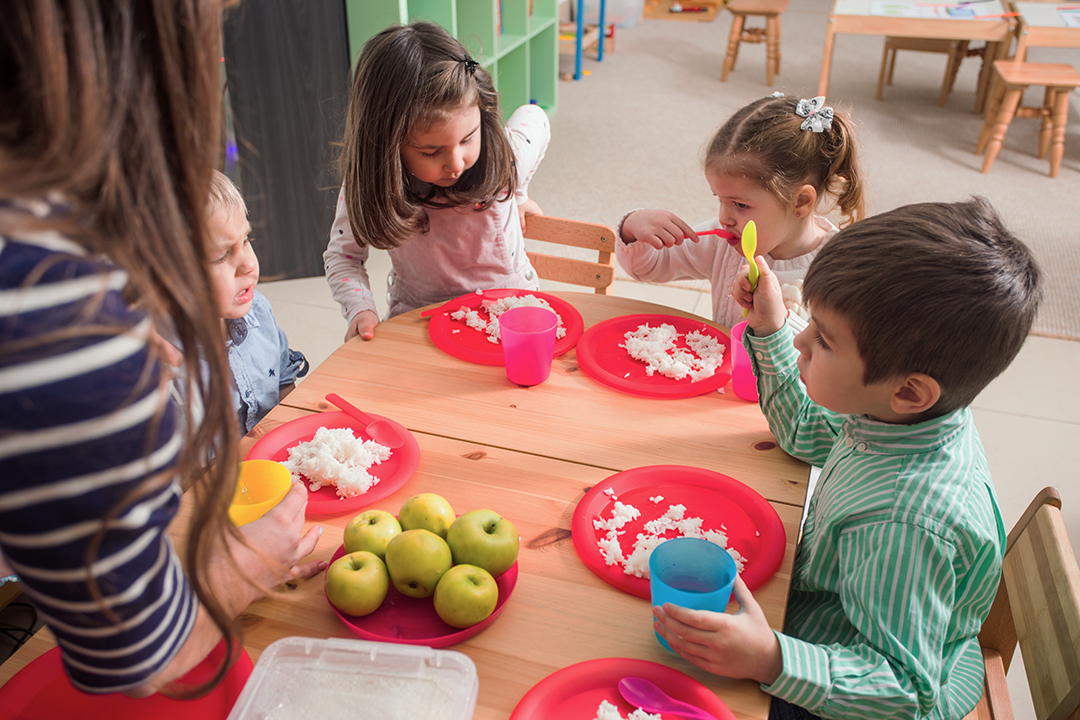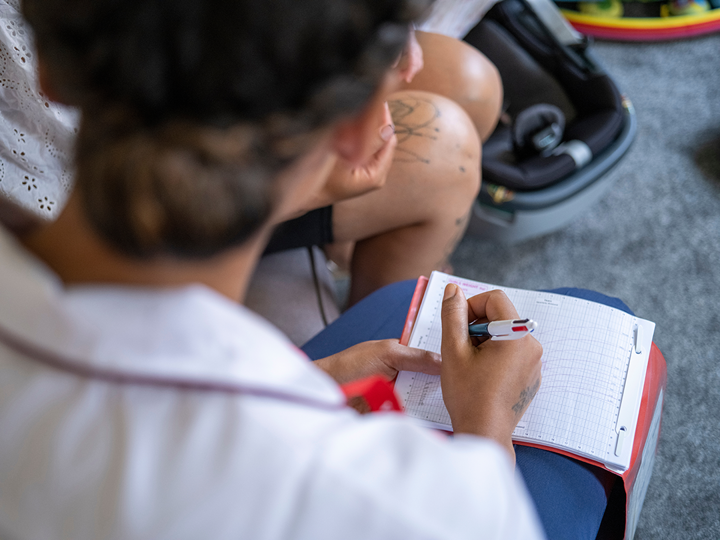Eating strategies for sensitive children
- 1-5 Years
- 5-11 Years
- 11-19 Years
- SEND
- Child development and growing up
- Feeding and eating

Mealtimes can be particularly hard for sensitive children and young people. There are lots of different textures, smells and tastes. This can make mealtimes stressful for them.
General strategies
When considering strategies, think about your child or young person. Try to identify what tasks or objects are upsetting your child or that your child struggles with. This is a process of trial and error, so when one strategy doesn't work, there may be another one to try instead.
There are strategies that can be used in lots of different situations. This include:
- Communicate with your child. You can use communication aids like social stories, picture symbols, visual schedules and sequence strips.
- Stay consistent. By sticking to a routine, your child can learn what is going to happen next. This helps reduce the stress around self-care activities.
- Keep the surroundings organised. Try to make sure things are put back in their place. This helps teach your child that this is where the item belongs. They will then be able to find the item by themselves and be more independent.
Adjusting mealtime expectations
Mealtimes can be frustrating and stressful for everyone. It's particularly stressful when you are concerned whether your child or young person is eating enough or eating healthily.
Adjusting what you expect at mealtimes can be helpful for you and your family. Mealtimes with children and young people with sensory needs or sensory differences can be different to what you might expect at mealtimes.
For some children and young people it can be helpful to offer different foods at different times of the day. For example, breakfast doesn't have to be cereal or toast, it could be a sandwich or salad.
Try to make sure that all your family members understand your child or young person's sensory needs.
Playing with food
Sometimes the textures of food can difficult for children. Playing with food lets your child safely explore food without having to eat it. They can get used to the natural textures and the feeling of the food.
It can be helpful for your child to accept foods by letting them take part in the cooking process or playing with nature outdoors. This can help your child understand where the food is coming from. It can also help them to gradually accept different textures.
Indoor play
- Playing with dry beans, rice or pasta
- Playing with different kitchen utensils like a wooden spoon, a spatula or tongs
- Playing with foods presented in different ways for example carrots can be cut into different shapes, grated, boiled, roasted, sautéed, puréed into a soup, fried or cut into ribbons.
- Sing songs about food like 'jelly on a plate' or 'one potato, two potato'
- Using toys or objects to touch foods they don't like like driving a toy through flour or pouring lentils through tubes
- Using food in messy play like using flour to build castles or watch flour sprinkle down like snow

Outdoor play
- Playing barefoot or in shorts and a vest outside (if the temperature and weather is appropriate)
- Playing outside in all weather like when it's sunny, cloudy or rainy
- Planting, watering and picking plants like fruits, vegetables and herbs, if you do not have an outdoor space you can plant herbs and vegetables indoors.
- Weeding a garden or pathway
- Looking for wild foods like blackberries in the countryside or in a park
- Taking trips to garden centres or allotments

Sitting at a table
How your child sits at the table can help them to eat. Sitting in an upright position will help their body to digest the food. It can give them a stable base and can help them to put the food in their mouths.
Your child's hips, knees and ankles should be at 90 degree angles. This is referred to as 90/90/90. The table surface should be halfway between their belly button and their nipples.

Some children can struggle to sit still for periods of time. Your child may find it helpful to eat with some movement. This can help your child to be more open to take part in mealtimes and try new foods.
Your child could sit on a:
- bouncing ball
- parent's lap
- rocker board
- wobble cushions
- vibrating cushions
Some children and young people struggle with being touched. It can help to position them at the end of the table to reduce the likelihood that they'll be touched by other people. You can make this more fun by setting it up like a small café table.
Food preparation
It's common for sensitive children and young people to really dislike certain textures or smells of food. Encouraging your child or young person to take part in preparing for mealtime can help them with this.
Your child or young person can help with food preparation lots of different ways:
Picking out food during the food shop. This can be online or in person. If you are able to go food shopping in person, they can touch the different fruits and vegetables to pick the right ones.
Helping you to write a weekly menu. Look at cookbooks with your child or young person and encourage them to pick out recipes they like the look of.
Preparing foods with you. This can be as simple as taking the pots and pans out of the cupboard or they can be involved in cutting vegetables or cooking.
Choosing their own plate. This can give your child a feeling of importance and independence. If you have delicate or fragile plates, give them a limited choice of plastic plates they can use. They may pick the same plate every time, still give them the choice to pick the plate they want.
Laying the table or clearing up.
Serving food.

It's important for you to be aware of the different textures and temperatures of food. Some children and young people can find these hard to tolerate. Work within what your child can tolerate. For example they may not like 'slimy' foods like whole mushrooms but can tolerate if the mushrooms are cut up very small.
Preparing for mealtimes
It can be helpful for some children or young people to exercise before eating. Exercise can help calm down the nervous system. This helps them to feel less sensitive to the sensations that usually bother them.
If your child is a messy eater, they may find it helpful to do blowing or sucking exercises before eating. This could be an activity like whistling, blowing bubbles or blowing a pinwheel. Blowing and sucking exercises can help your child to get better at closing their mouth as they eat. They can also help your child to understand the senses around their mouth.
The 'just right' challenge
This is when an activity is at a difficulty level that is 'just right' for your child. The activity shouldn't be so easy that there's no challenge but it also shouldn't be so hard that it's frustrating or overwhelming. It's like the story of Goldilocks when Goldilocks is trying the chairs, the beds and the porridge of the 3 bears.
Make sure not to offer foods that your child can't manage. This can be frustrating and overwhelming for your child.
Change your expectations
Your child or young person doesn't have to eat in the typical way with a knife and fork. If your child finds using a spoon or eating with their fingers easier, let them do this.
Understand what your child or young person can do with the food
Find out what your child or young person is comfortable doing with the food. This can be touching the food, smelling the food, having the food on their plate. This can be used as a small challenge when they're feeling calm.
Find out what types foods your child can manage
Finding the foods that your child or young person will eat comfortably will be very helpful. They may like:
- different textures like purees
- bite and dissolving foods like wafer biscuits, multigrain hoops or cheese straws
- soft foods like bananas or
- crunchy foods like crisps or rice cakes
You can then offer similar foods in the categories as a smaller challenge.
During meal time
Let your child or young person feel the food before eating it. This can be messy but it can help them feel more comfortable with the foods.
Place a small makeup mirror on the table. Being able to see what they are doing in the mirror can help some children and young people. It can help your child or young person to accurately place food in their mouth and clean their face after each bite.
Encourage your child or young person to 'clean' their mouth with water between mouthfuls of food. This can be helpful for children and young people who have very sensitive mouths or have sensory issues with brushing their teeth. It can also encourage them to drink more water.
Provide napkins or wipe at the table. This can encourage your child to clean their own face and hands. Try not to wash their face as they are eating.
Encourage them to move their food away instead of moving themselves. For example, pushing the plate forward instead of pushing their chair back. When your child or young person pushes the plate away, don't let them move the food back.
Equipment that can help at mealtimes

![]()
Equipment is not always needed but it can help your child to feed themselves.
Easy grip cutlery. Cutlery that is designed to be easier to use with thicker handles. They can also have reminders for where your child can place their fingers.
Weighted cutlery. Heavier cutlery sends more information to the brain. This is called sensory feedback. This can help your child to be more accurate in their movements.
Weighted cups. These can be great if your child often spills their drink. Similar to weighted cutlery, a heavier cup provides more sensory feedback. This can help your child to be more accurate in their movements.
Cups with lids and straws. This can be great if your child often spills their drink. For some children sucking a drink up through a straw can be calming.
Non-slip mats. If the plate moves around a lot, getting a non-slip surface can help.
Weighted vests or a heavy lap cushion. This can be calming for some children and young people. It can help them sit at a table for longer.
Last reviewed: 1 November, 2024




